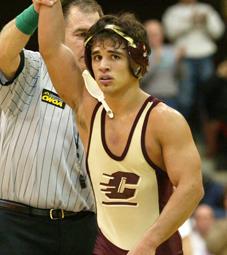At one time the NCAA had a 118 lbs weight class. If you go back far enough, 115 lbs. This weight class lasted through the 1997-1998 season. After the death of three wrestlers, all of whom died from excessive weight cutting, the wrestling community decided to reevaluate the weight classes and make changes to reflect health and safety. The 118 lbs weight class was eliminated.
Most agree with the changes that were made. The pros of the decision have been illustrated well in the past twenty years. Not everyone is happy though. Ask NCAA champion and 1982 World Bronze Medalist Joe Gonzalez his opinion on the elimination of the 118 lbs weight class. He'll tell you how he feels.
"Wrestling is one of the only sports that gives small, short guys an opportunity to show how good of athletes they are." Says the former Road Runner. "Eliminating 118 lbs is discriminating to the kids that finish their high school career wrestling at a lower weight class. It's like college wrestling is telling those kids they aren't welcome. It is very exclusionary. It isn't right."
Gonzalez has a point. Wrestlers that wrestled in yesteryear's 103 lbs or 112 lbs weight class as seniors had a weight class they could naturally grow into at 118 lbs. Today's seniors that graduate at 106 lbs would be able to as well.
The truth is, not everyone is big enough to be a 125 lbs wrestler. Not everyone can put on enough size and strength in order to be competitive at the weight class. Looking over the past 19 years, there have been a number of wrestlers who would have benefited from a 118 lbs weight class. We'll take a look at five of those wrestlers.
| Jesse Miramontes |
 |
| Eric Olanowski |
 |
| Thomas Williams |
 |
| Luke Smith |
Of course this is all speculation and a subjective view of what could have been. 125 lbs isn't going anywhere as college wrestling's lowest weight class. The chances of 118 lbs ever coming back to wrestling may not be 0%, but they might as well be. The point of this article isn't to campaign for the return of 118 lbs. It is simply to make point that there were cons to the elimination of the weight class and despite the many positives that came about, there were negatives too.
And with the question already being begged at this time, it might as well be asked.
Who over the years would have benefited from a 241 lbs weight class? Who would have benefited from a time when the HWT class had no weight limit?
No comments:
Post a Comment